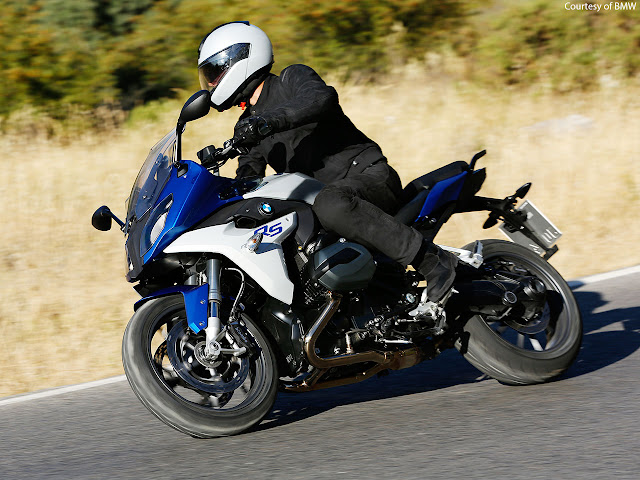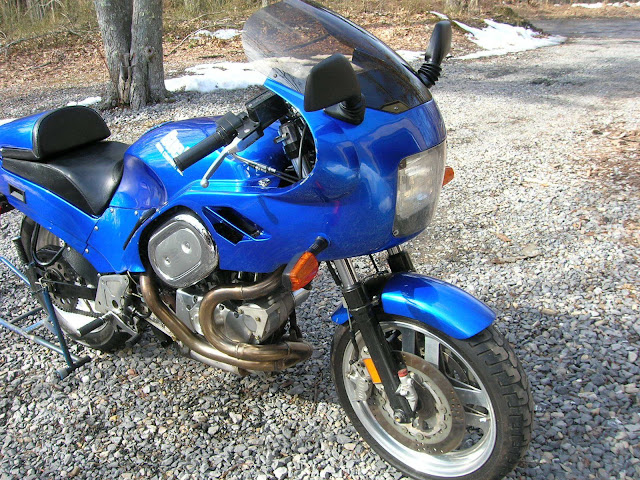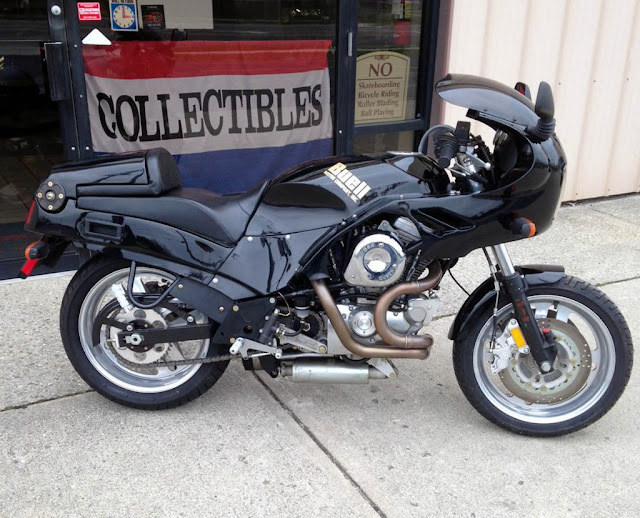Buell RS1200
Buell's RSI200. also known as the Westwind, featured streamlined bodywork but left its Harley-Davidson V-twin engine visible beneath the flowing fibreglass fairing tank/seat unit. Particularly distinctive features included the hinged pillion-seat backrest and the rear shock, which was located horizontally beneath the engine and worked in tension rather than the normal compression.
In recent years, motorcyclists worldwide have become familiar with Buell’s growing range of sport bikes, powered by V-twin engines from the marque’s parent company Harley-Davidson. Buell's status was very different back in 1989. when founder Erik Buell and his small team from Mukwonago in Wisconsin - close to Hurle\ ‘s Milwaukee base - began production of the RSI200.
Just like modern Buells, the RSI200 was a sporty. American-built machine, powered by a Harley-Davidson engine. It combined innovative chassis engineering with distinctive styling that left the big V-twin in full view. And it fully lived up to Buell’s slogan: ‘America's Faaast Motorcycle’.
The RSI200 was not Buell’s first Harley- powered model. Erik, a former National level road- racer and Harley engineer, had begun in 1987 by creating the RR1000 Battletwin, which held a Harley XR1000 engine in a chassis of his own construction. The RR1000, and also the 1200ec
Sportster-engined RR1200 that followed when stocks of the XR unit ran out, featured windcheating bodywork, incorporating a huge front mudguard plus integrated fairing and single seat.
Its aerodynamics boosted the Battletwin’s performance but detracted from the impact of the Harley powerplant. even when the bodywork was painted in Milwaukee's traditional orange, black and white. So Erik Buell went back to the drawing board for his next model, the RSI200, which retained the RR's mechanical format but put the engine on show.
In standard form the RSI200 left the Sportster motor untouched, although it was boosted slightly bv a SuperTrapp exhaust system that increased output to about 60bhp. But it was for its chassis that the RSI200 was special. Erik Buell's frame was a tubular steel ladder that held the motor via his Uniplanar system, which used rods and joints to restrict engine vibration to the vertical plane. This allowed the engine to be rubber-mounted, while also adding rigidity as a stressed member of the chassis. The Works Performance rear shock sat horizontally beneath the engine, working in tension rather than compression.
Front forks were Marzocchi units modified with Buell’s own anti-dive system. Even the 17-inch wheels and four-piston front brake calipers were his own work, as was the fibreglass bodywork. The neat fairing/tank/tailpiece unit featured a seat hump which hinged to become a backrest for the pillion.
The RSI200 was a light and torquey bike which, although not hugely powerful, was ver\ quick on the right road. Acceleration from low engine speeds was addictively strong, and the Uniplanar system was effective in isolating the Harley motor's normal vibration. Even when revved hard, the Buell remained very smooth to its top speed of 120mph (193km/h).
More to the point, the RS1200's compact, rigid chassis provided very good handling. The RSl200's racy steering geometry and firm forks gave quick steering plus excellent stability. marred slightly by the rather vague rear suspension set-up. Although the hand-built Buell was expensive, costing more than twice as much as a Sportster, its style, innovative engineering and V-twin punch made an appealing combination.
Far left: The softly tuned 1200cc pushrod V-twin m - Harley's Sportster was left internally standard, but a new SuperTrapp exhaust system increased peak output slightly to 60bhp.
Buell’s innovative chassis worked well, giving the RSI200 a smooth ride plus handling that enabled it to compete with more powerful bikes in corners.
Erik Buell's big break came in 1993, when his former employer Harley-Davidson, looking to get into the sport bike market, bought a 49 per cent stake in his firm. The following year, the renamed Buell Motorcycle Company launched the S2 Thunderbolt, based on the RS1200 but with fresh styling, numerous detail improvements and a 20 per cent power increase due to improved breathing. With top speed up to 130mph (209km/h), and a lower price due to increased production, the Thunderbolt was the fastest and most competitive Buell yet.
Specification Buell RS1200 (1989)
- Engine Air-cooled ohv pushrod four
- Capacity 1200cc (88.8 x 98.8mm)
- Maximum power 60bhp @ 5000rpm
- Transmission Four-speed, chain final drive
- Frame Tubular steel ladder
- Suspension Telescopic front; single shock rear
- Brakes Twin discs front; disc rear
- Weight 450lb (204kg)
- Top speed 120mph (193km/h)























0 comments: